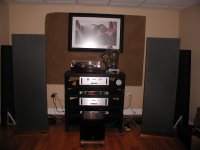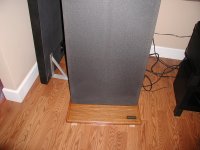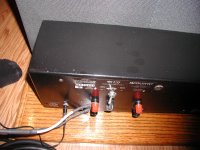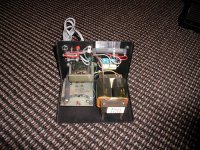Acoustat 2 + 2 is 4 dB down in SPL
Hi Andy,
I'm a long time Acoustat owner 1990 till know bought a 2 + 2 new with the red medaillon sticker at the back.
I added some info about the line-up of the Acoustat slimline series running from One to Model Eight and how to drive them properly.
Lately one speaker is down for 4dB. I cleaned and resoldered all the contacts and soldering joints checked the fuses an measured approx. 750 Volts after the stepuptrafo. In the past I had similar problems also but re-energizing the bias mostly solved it. All the four panels of this panel are working and it's the entire frequency spectrum that seems to be affected so I reckon it must be the biascircuit. Any advice what would be the possible cause/offfender?
Hello Audio Enthusiasts! Some of you may know my work on www.audiocircuit.com, where for many years I have been helping to advise Acoustat owners. I was an engineer and manager with Acoustat, starting when the David Hafler Co bought Acoustat out of bankruptcy, right up to the very end of US production under Rockford Corp ownership (sad day that was!). So I thought I'd lend a hand here, too, because I LOVE Acoustats and want to help as many owners as possible to keep their Acoustats running for many years to come. I don't sell parts or do repairs, but my advice is FREE! So let me know how I can help YOU with your ACOUSTAT's! (And this being a DYI crowd, I don't mind discussing modifications to the speakers.)
Andy Szabo
Hi Andy,
I'm a long time Acoustat owner 1990 till know bought a 2 + 2 new with the red medaillon sticker at the back.
I added some info about the line-up of the Acoustat slimline series running from One to Model Eight and how to drive them properly.
Lately one speaker is down for 4dB. I cleaned and resoldered all the contacts and soldering joints checked the fuses an measured approx. 750 Volts after the stepuptrafo. In the past I had similar problems also but re-energizing the bias mostly solved it. All the four panels of this panel are working and it's the entire frequency spectrum that seems to be affected so I reckon it must be the biascircuit. Any advice what would be the possible cause/offfender?
Hello Andy et al,
I have just finished restoring a pair of Spectra 22. I rewired the wall wart jack to the bias pcb and anchored the new jack to the I/F box - no longer just secured to the bias PCB - using a new rat shack 1/8" jack, reglued some bias wires to the lattice - which was the real buzzing problem with these speakers initially, blew out the panels with compressed air, washed the original socks, and re-finished the bases. Aside from a couple small holes in sock, they look brand new. They definitely have less beaming and sound livelier than the Model 2 equivalent. I was actually surprised on how much bass it has too. I have to decide if it is a keeper, as I have too many speakers, (my Apogee Duetta Sigs currently rule the roost), and also have plans to someday build a monster Model 6 or 8 (I have a total of 6 9" panels so far)...decisions decisions...
I must say that the design of the Spectra interfaces is quite unique as there are no crossover components on the frontside of the step up trannies. I look at the wiring diagram and see that for a two panel, the outer section of the outmost panel is run full range, while the other three are mid/low and low. Interesting. Going from two to three panels just adds more low end? I really wonder what these would sound like with both panels (all four sections) are run full range, and a pair of regular panels from my model 3 just wired to the low connections on the spectra interface.
Anyway, my question, I have a couple Model 1 MK-141 interfaces and the step up trannies look a lot like the step up trannies used in the Spectra...are they the same? I have attached a pic of the speakers as they now look, and a pic of the MK-141 interface showing the step up tranny....
I have just finished restoring a pair of Spectra 22. I rewired the wall wart jack to the bias pcb and anchored the new jack to the I/F box - no longer just secured to the bias PCB - using a new rat shack 1/8" jack, reglued some bias wires to the lattice - which was the real buzzing problem with these speakers initially, blew out the panels with compressed air, washed the original socks, and re-finished the bases. Aside from a couple small holes in sock, they look brand new. They definitely have less beaming and sound livelier than the Model 2 equivalent. I was actually surprised on how much bass it has too. I have to decide if it is a keeper, as I have too many speakers, (my Apogee Duetta Sigs currently rule the roost), and also have plans to someday build a monster Model 6 or 8 (I have a total of 6 9" panels so far)...decisions decisions...
I must say that the design of the Spectra interfaces is quite unique as there are no crossover components on the frontside of the step up trannies. I look at the wiring diagram and see that for a two panel, the outer section of the outmost panel is run full range, while the other three are mid/low and low. Interesting. Going from two to three panels just adds more low end? I really wonder what these would sound like with both panels (all four sections) are run full range, and a pair of regular panels from my model 3 just wired to the low connections on the spectra interface.
Anyway, my question, I have a couple Model 1 MK-141 interfaces and the step up trannies look a lot like the step up trannies used in the Spectra...are they the same? I have attached a pic of the speakers as they now look, and a pic of the MK-141 interface showing the step up tranny....
Attachments
Last edited:
Beyond the similarity in physical appearance (both transformers are constructed with U-I laminations) the Spectra transformers and the MK-141 transformers are very different. The MK-141 is a dual-phase, limited-frequency range unit, whereas the Spectra transformer is a single-phase, full-range unit. So, you can't make a Spectra using an MK-141 transformer.
Hi Andy,
I'm a long time Acoustat owner 1990 till know bought a 2 + 2 new with the red medaillon sticker at the back.
I added some info about the line-up of the Acoustat slimline series running from One to Model Eight and how to drive them properly.
Lately one speaker is down for 4dB. I cleaned and resoldered all the contacts and soldering joints checked the fuses an measured approx. 750 Volts after the stepuptrafo. In the past I had similar problems also but re-energizing the bias mostly solved it. All the four panels of this panel are working and it's the entire frequency spectrum that seems to be affected so I reckon it must be the biascircuit. Any advice what would be the possible cause/offfender?
Robert-
You probably have a problem with the 5-stage bias multiplier. This consists of 5 capacitors and 5 diodes. I would replace all 5 capacitors, as these are known to fail after some time. The diodes may also be faulty, but replacements are hard to find, so try the capacitors first. You don't need anything fancy here - replace them with ceramic disc-types with the same voltage (or higher) and same capacitance as the original parts.
An externally hosted image should be here but it was not working when we last tested it.
You lucky devil ANY Jeff Rowland would do a very good job on Acoustats the model 8 is a stereo amp are you using two of them bridged mono if so for me this is OVERKILL and you are losing on QUALITY to get more QUANTITY just try one amp and let us know what you think don't forget that this amp was designed for STEREO amplification good luck and enjoy.
PS: If you do want big mono blocks may i suggest the KING the model 9s with seperate power supply or the smaller model 7s

Last edited:
sure there are: Audiostatic - Pure full range electrostatic loudspeakers
Are there any manufactors who still make full range ESL's? If so, how much do they go for?
Are there any manufactors who still make full range ESL's? If so, how much do they go for?
There are many but NONE are cheap here are just a few of the very best.
http://www.soundlab-speakers.com/
Audiostatic - Pure full range electrostatic loudspeakers
Products|Electrostatic P3.1|Audio Exklusiv - High End Audio, Elektrostatische Laustprecher, Elektrostat, P3.1, Audio Exklusiv Shop + Zubehör, Pütz Elektrostaten
Products|Electrostatic P6.1|Audio Exklusiv - High End Audio, Elektrostatische Laustprecher, Elektrostat, P3.1, Audio Exklusiv Shop + Zubehör, Pütz Elektrostaten
King Sound - Speakers
MartinLogan | CLX ART - The World's Finest Full-Range Electrostatic Line Source Loudspeaker
Last edited:
Ih Roberts,
Could you fix the issue by changing the diodes and caps ?
I had the same problem several times in the past, and found the possible cause to be :
- One of the yellow capacitor was dead. This issue I had 2 times. You can check it by exchanging them from one interface to the other.
- One of the High tension ladder diode is dead
- One of the wire which goes to the pannels is crushed between the pannel and the wood structure.
Regards,
Mathieu
Could you fix the issue by changing the diodes and caps ?
I had the same problem several times in the past, and found the possible cause to be :
- One of the yellow capacitor was dead. This issue I had 2 times. You can check it by exchanging them from one interface to the other.
- One of the High tension ladder diode is dead
- One of the wire which goes to the pannels is crushed between the pannel and the wood structure.
Regards,
Mathieu
Ih Roberts,
Could you fix the issue by changing the diodes and caps ?
I had the same problem several times in the past, and found the possible cause to be :
- One of the yellow capacitor was dead. This issue I had 2 times. You can check it by exchanging them from one interface to the other.
- One of the High tension ladder diode is dead
- One of the wire which goes to the pannels is crushed between the pannel and the wood structure.
Regards,
Mathieu
Salut Mathieu proprio d'une belle paire de 1+1 modifiée, quelques photos des Acoutats modifiées par Jocelyn.
http://www.flickr.com/photos/mracoustat/
It's easy to find better high voltage diodes and capactors on Ebay ( 10 to 30 kv) - change them all at the same time. Yes overkill, but great reliability, they fit the board, and even though they are Chinese parts they are so oversized that they work fine in Acoustat and other step ups.
MartinLogan uses 1KV 1amp soft recovery diodes in the CLX with film caps, but ML use smaller steps for each step of the voltage multiplier so the voltage on each diode and cap is lower. Do not use these soft recovery 1kv diodes on Acoustats as the voltage on the diode is too high. Older ML models units used 1N4007. I suspect ML used the larger number of steps to be able to use more commonly available and better sounding parts , cheaper too!
MartinLogan uses 1KV 1amp soft recovery diodes in the CLX with film caps, but ML use smaller steps for each step of the voltage multiplier so the voltage on each diode and cap is lower. Do not use these soft recovery 1kv diodes on Acoustats as the voltage on the diode is too high. Older ML models units used 1N4007. I suspect ML used the larger number of steps to be able to use more commonly available and better sounding parts , cheaper too!
It's easy to find better high voltage diodes and capactors on Ebay ( 10 to 30 kv) - change them all at the same time. Yes overkill, but great reliability, they fit the board, and even though they are Chinese parts they are so oversized that they work fine in Acoustat and other step ups.
MartinLogan uses 1KV 1amp soft recovery diodes in the CLX with film caps, but ML use smaller steps for each step of the voltage multiplier so the voltage on each diode and cap is lower. Do not use these soft recovery 1kv diodes on Acoustats as the voltage on the diode is too high. Older ML models units used 1N4007. I suspect ML used the larger number of steps to be able to use more commonly available and better sounding parts , cheaper too!
The original diodes used by Acoustat are rated at 10 kV at 25 mA. Although diodes with a higher rating (either voltage and current) may be used, their larger physical size may preclude mounting them easily to the PCB.
Likewise with the capacitors, using ones with a higher voltage rating than original is okay, but may cause difficulty with mounting them in the board. I see no value in replacing them with other than the original ceramic-disc types. The capacitance value should remain the same as original.
Although the components in the bias voltage multiplier do 'wear out' after time, or fail outright, the original circuit design is quite adequate to the task and I would recommend against any changes to the original design.
I was given a pair of Model 3 Acoustats (they had been sitting in back of a closet for 20+ years) both panels seem to be in good shape but one the MK-121-2 was bad, the 500Mohm resistor was dead and I'm not sure if that is the only thing wrong. If someone could give me advice on where to source a new 500M resistor or pair of them if it would be better to replace them on both panels I'd appreciate it. And if there is anything else I should check on them.
I was given a pair of Model 3 Acoustats (they had been sitting in back of a closet for 20+ years) both panels seem to be in good shape but one the MK-121-2 was bad, the 500Mohm resistor was dead and I'm not sure if that is the only thing wrong. If someone could give me advice on where to source a new 500M resistor or pair of them if it would be better to replace them on both panels I'd appreciate it. And if there is anything else I should check on them.
How did you determine that the 500M-ohm resistor is bad? Due to the extremely high value, these are not measurable with an ordinary ohmmeter (they will measure as an open circuit).
Finding an exact replacement will be difficult, as these resistors were always a special-order item for Acoustat. The good news is that the exact value is not citical - try to get as close to 500M as possible, although you could probably get away with going as low as 100M. I would not recommend a higher value than 500M.
Your best bet is to find something from a electronics surplus supplier, many of whom advertise on eBay. The resistor should be rated for at least 5000 volts (5kV). I would recommend replacing both resistors at the same time, especially if you use a different value from the original.
Can some tell me if the Blue wire off the Acoustat 121 stock interface setup gose to front are back of the panels??.............Thanks
The BLUE wire goes to the rear stator, and the WHITE wire goes to the front stator.
I didn't realize that my speakers were disconnected from 120v, turned volume up a couple
times before I realized it.
They sound fine but is there a chance I damaged them and if so, how
Would I know?
They are 2+2's.
If they sound okay, you probably did no damage.
- Home
- Loudspeakers
- Planars & Exotics
- Acoustat Answer Man is here



